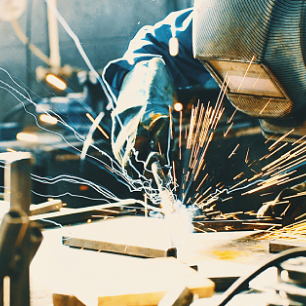Jump to:
Enabling High-Performance Manufacturing through Friction Stir Welding
Since its inception in the late 1990s, friction stir welding (FSW) has evolved from a niche application in the aerospace industry into a widely adopted technology across various manufacturing sectors. Automotive, consumer electronics, and medical manufacturing are just some of the segments now reaping the benefits of this versatile, accurate, and repeatable process. With the integration of automation, data analysis, and machine learning, FSW is further expanding as a flexible, cost-effective joining process in various applications.
A Joining Process in Disguise
At first glance, the FSW process may resemble a milling process gone bad, but it’s actually a precisely controlled solid-state joining technique. FSW uses a tough cylindrical tool comprised of a shoulder and pin that spins and plunges into the joint between two pieces of metal. Features of both the shoulder and pin, such as threads, flats, and scrolls, influence heat input. The friction caused by the spinning tool and downforce plasticizes the metal without melting it, since temperatures reach only about 70 to 80% of their melting points. As the softened material flows around the tool, it is forged at the trailing edge and cooled into a high-strength weld. The process relies on substantial forces — often measured in thousands of pounds — and requires precise control of parameters such as tool design, rotational and travel speeds, axial path, and cross-direction forces.
As an enabling technology, FSW allows manufacturers to fuse metals that are difficult or impossible to join, including aluminum. FSW can also join dissimilar metals, such as aluminum to steel or copper to aluminum, along with other materials whose mechanical properties degrade under traditional joining processes.
FSW also brings advantages in maintaining the original properties of the joined metals. Because FSW is a solid-state process, there is less molecular mobility during fusion. Secondly, FSW produces a more limited heat-affected zone and thermo-mechanically affected zone that tends to alter the physical characteristics of the metals at the molecular level.
FSW Is Getting Its Wings
From the beginning, FSW was well-suited to aerospace manufacturing, where aluminum is a prime component material. Aluminum can experience more than a 60% reduction in strength when joined with traditional fusion processes, but only about a 10% loss is seen when FSW is utilized. The industry also uses many exotic materials considered difficult or nonfusible with traditional joining methods. Low volumes, high margins, and the inherent scientific research and development in cutting-edge aerospace design and manufacturing allow engineers to experiment with FSW parameters and processes to establish what does and does not work under varying scenarios.
The Road to Wider Use
With its benefits defined and established in aviation, FSW was favorably positioned for the auto industry when it began incorporating aluminum into its designs. As the demand for greater flexibility and cost-efficiency outpaced the capabilities of the large, cumbersome gantry welding systems used in aerospace fabrication, companies like KUKA began applying their expertise in robotics and automation to meet the challenge. Automated FSW allows automakers to capitalize on fast, accurate, and repeatable performance to meet the cycle times and cost demands of the modern assembly line.
With the move to electric vehicle platforms, this change became a major catalyst for FSW expansion. FSW is actively used in the fabrication of body panels, suspension components, heat exchangers, and, especially, aluminum EV battery housings. The process enables the fast and precise creation of leak-tight, spatter-free joints without compromising the metal’s weld strength.
Going Mainstream
Increased sophistication in equipment and processes has allowed FSW to move into the manufacturing mainstream. Large extrusions used in ship decks and rail cars are joined using FSW to create wider panels. These sectors represent the highest total linear length of FSW annually. Heat exchangers for high-voltage electronic applications, battery modules, and energy sector component manufacturing are now seeing increased use of FSW.
Determining FSW’s Suitability
Whether FSW is appropriate for a given application depends on several conditions. The threshold of the issue centers on the weld joint requirements, such as the amount of force the joint will experience. The answer to this question will determine which material will be used. As previously discussed, FSW may be the only option available when dissimilar materials are needed. Part preparation and throughput requirements will also impact the decision. Gas metal arc and gas tungsten arc welding have much higher heat inputs than FSW and additional consumable costs, whereas automated robotic FSW improves production significantly.
FSW can require a larger capital investment compared to traditional welding systems. However, that cost can be offset by other factors, such as eliminating the need for certain postweld processing. FSW could save substantial sums in part costs over a year.
Into an AI-Driven Future
Automation technology companies are now conducting research to pair robotic FSW with artificial intelligence (AI). Welding forces, temperatures, vibrations, and other parameters can be measured and monitored by fitting various sensors to the robotic welding machine. Analyzing this data provides insights into weld quality and supports process optimization. Researchers are working toward real-time machine learning, adjustment, and optimization by comparing process data to weld outcomes. By recognizing anomalies and errors and making the necessary adjustments, manufacturers can reduce the number of postprocess weld inspections, thereby improving productivity and reducing costs.
Conclusion
As processes continue to improve and AI increases its role in FSW, the technology will expand even further to new applications and manufacturing segments. Machine learning will allow robotic FSW cells to adjust in real time to sensor feedback and produce accurate, repeatable welds in a variety of situations and applications. Faster welds with fewer postprocess inspections mean more production and less cost per part. As a result, FSW will expand into more industries, enabling manufacturers to forge new paths in material joining.
JAMES CRUZ (james.cruz@kuka.com) is business development manager of advanced welding solutions at KUKA, Shelby Township, Mich.


